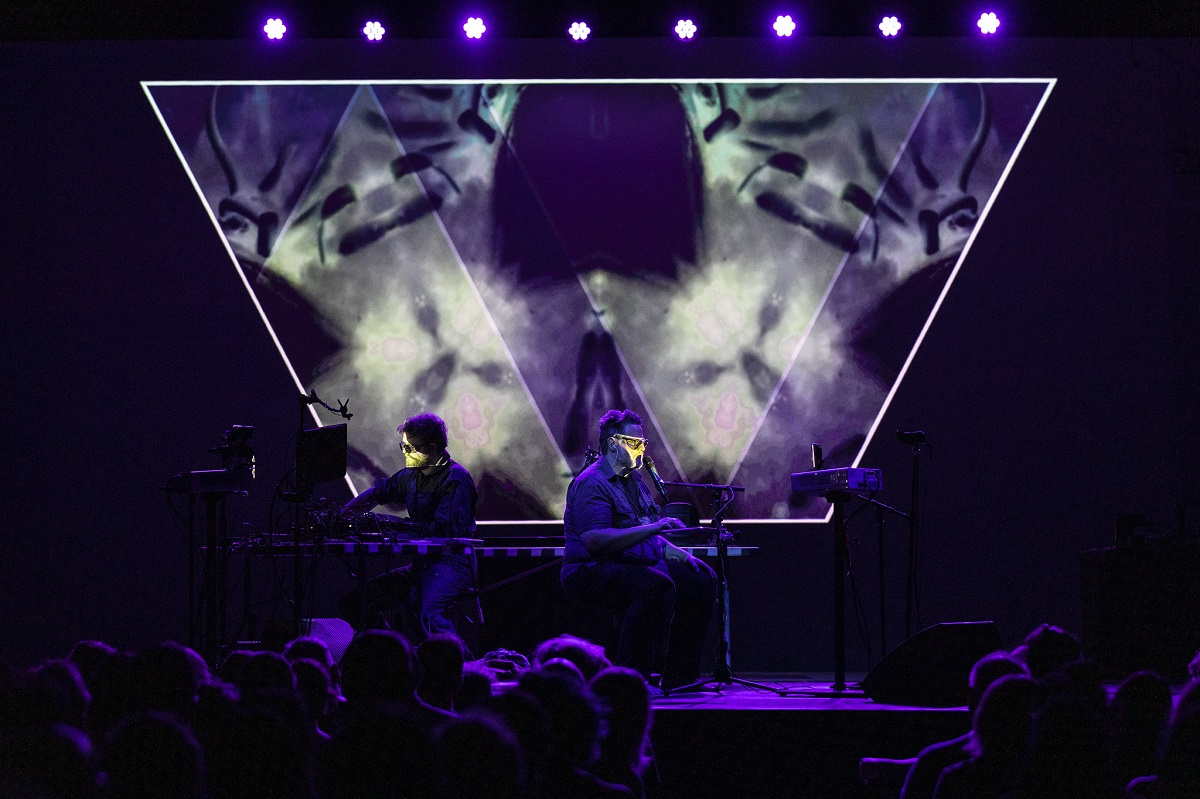
DECODER: Ticket that Exploded
Text by WIlliam S. Burroughs
Conceived and directed by Mallory Catlett
Presented by Restless NYC at Pioneer Works, NYC
July 8, 2019
In the late 1950s and early 1960s, Beat Generation artist and writer William S. Burroughs popularized the "cut-up technique," a method dating to at least the Dada movement of cutting up a text or texts and rearranging the pieces to form a new composition. Burroughs employed a "fold-in" variation (reading across two vertically folded sheets placed side by side to create a new page) for his novel The Ticket that Exploded, first published in 1962 and in a revised and expanded version in 1967. This story of mind control and intergalactic conflict also describes Burroughs's theories about language, technology, and the cut-up technique, and it forms part of The Nova Trilogy, along with The Soft Machine (1961, revised 1966 and 1968) and Nova Express (1964). With DECODER: The Ticket that Exploded, creator and director Mallory Catlett, in collaboration with video designer Keith Skretch, associate video designed Simon Harding, interaction designer Ryan Holsopple, and scholar Alex Wermer-Colan, Burroughs's novel is reimagined, partly through his own techniques, as a psychedelic live enactment that assembles language, imagery, and sound into an engrossing experience somewhere between theater and performance art.
Played out in this performance on a raised stage in the cavernous interior of Pioneer Works in Red Hook, DECODER is brought to fractured life by collaborators and performers G. Lucas Crane and Jim Findlay. Crane, the "tape DJ" and sound artist, acts as the primary operator of the onstage audiovisual equipment -- and provides an excellent lemur call -- while Findlay handles the spoken portions of the production. The spoken elements use Burroughs's own words, and audience members can catch indications of his influence on in phrases such as "well, that's like hypnotizing chickens," borrowed from The Ticket That Exploded by Iggy Pop in "Lust for Life," and "heavy metal," first appearing in print in The Soft Machine. The cassette tape recorders that Crane so skillfully manipulates are referred to in pre-recorded dialogue early on in the show as an "externalized part of the human nervous system," and they are positioned in relation to "the Word," what it is and what can be done with and to it, not least the assertion that cut-up offers a means of being one's own agent. While there is, unsurprisingly, no conventional narrative, DECODER does evince a loose thematic structure, with other sections with spoken and recorded text about, for example, sexuality (at some points as "flesh addiction" and at others as a kind of literal merging of bodies), war (as, in one memorable passage, an ongoing game the only possible end to which is the atomic destruction of all the players), and questions about topics including time, self, and embodiment.
Juxtaposition represents an important aspect of the cut-up technique, creating and influencing meaning, and the various forms of "the Word" in the production are juxtaposed not only to one another but also to sound- and image-scapes throughout. The large trapezoidal screen at the back of the stage is filled with images that range from Crane's hands as he works or his face as we hear his amplified breathing to a distorted portion of Findlay's face as he declaims from beneath a welder's mask to insects, trees, tentacles, claws, and, in a visual metaphor for the "war game," the repetitive, mechanical stacking of logs. Often, when the projected images are distorted, it is along a vertical fold, much as Burroughs recommends for pages in the fold-in technique. At times, they also resolve into unexpected forms or accrue unexpected meaning, as when, through repetitive juxtaposition, a microphone held by Mike Pence becomes associated with a masturbated phallus, an oddly posed body shows up in a wooded landscape, or the bright whiteness, which juxtaposition with the dialogue leads one initially to think might represent outer space, is eventually clarified as snow through which a lone figure walks. Crane and Findlay themselves are central elements of some striking images, their bodies silhouetted, serving as canvases for flashing lights, or badly (on purpose) lip-syncing recorded questions. Crane is extremely impressive and has an engaging presence, and it would be easy to overlook how good Findlay's performance is because of the non-traditional part, but he adds energy and nuance to his role as primary conduit of the Word, as when he touches Crane during a particular speech or in the modulation that occurs when he sets aside the novel from which he has been reading directly and his delivery becomes subtly but clearly more hesitant, immediate, and, thus, seemingly authentic.
Late in DECODER is a discussion of a giant mechanical brain used by enemy forces that works through aggregating images and words and sounds like what we now call A.I. The dialogue recommends guerilla war against it, in one of a couple of times when the "you" seems to deliberately include the audience. Burroughs held that the cut-up technique can militate against the way that word and image lock us in to conventional modes and patterns of thought and perception. DECODER: Ticket that Exploded provides an intriguingly avant garde, visually arresting, and even at some points funny volley in this crusade against conventionality. And this is just the start: the full Nova Trilogy will premiere at the Chocolate Factory in Queens in 2020, to further rearrange our expectations of what theater can be. - Leah Richards & John Ziegler
